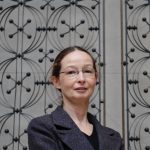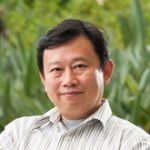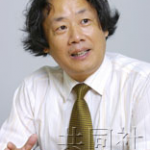Please click here to return to the main conference page.
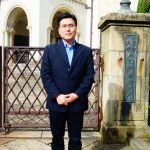 |
1. Bian Dongbo 卞東波 (University of Nanjing 南京大學): 漢籍東傳與異域闡釋——論中國詩僧文集的日本注本 (dongbobian@sina.com) Bian Dongbo(卞東波)is a Full Professor of Classical Chinese Literature at Nanjing University. He earned his PhD in 2006 from Nanjing University. From 2006 to present, he has served as a full-time Researcher in the Institute for Asian Classics Studies at Nanjing University. From 2008-2009, and 2014-2015, he was a Visiting Scholar at Harvard-Yenching Institute and Department of East Asian Language & Civilization at Harvard University. In 2011, he was invited as a Visiting Associate Professor by Kyoto University, Japan. During June 2013, he visited Waseda University as an Exchange Researcher. In 2018, he was invited as the Visiting Professor at the Institute for Research in Humanities, Kyoto University.His studies focus on Classical Chinese Literature, Comparative Literature among East Asian Community, and Overseas China Studies. He is the author of a number of books, including Tangsong Qianjia Lianzhu Shige: A Critical Study (唐宋千家聯珠詩格校證,Nanjing: Phoenix Publishing House, 2007), Southern Song Anthologies and the Poetics of Song Dynasty (南宋詩選與宋代詩學考論,Beijing: Zhonghu Book Company, 2009), Studies on the Poetry Remarks and Poetic Bibliographies in Song Dynasty (宋代詩話與詩學文獻研究,Beijing: Zhonghu Book Company, 2013), Studies on Asian Classics and Song Dynasty Literature(域外漢籍與宋代文學研究,Beijing: Zhonghu Book Company, 2017). He co-edited An Illustrated Catalogue of Japanese Rare Books in Classical Chinese(日本漢籍圖錄,Guilin: Guangxi Normal University Press, 2014). He edited the Collection of the Annotations on Hanshan’s Poetry in Edo Japan(寒山詩日本古注本叢刊,Nanjing: Phoenix Publishing House, 2007). He also is the translator of The Problem of a Chinese Aesethic ( 中國美學問題,by Haun Saussy of the University of Chicago, Nanjing: Jiangsu People’ s Publishing House, 2009). New Light Shed on the Old Tradition: Selections of Classical Chinese Literature Studies in North America ( 中國古典文學研究的新視鏡:晚近北美漢學論文選譯,Hefei: Anhui Education Publishing House, 2016). |
|
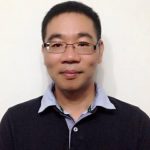 |
2. Chen Jinhua (UBC): The An Lushan Rebellion and East Asian Buddhism: With a Focus on Tang-Zhou China’s Commercial and Religious Ties with Central Asia (jinhuachen2013@gmail.com) Jinhua Chen is Professor of East Asian intellectual history (particularly religions) at the University of British Columbia, where he also served as the Canada Research Chair in East Asian Buddhism (2001-2011). He additionally held short-term teaching positions at other universities including the University of Virginia (2000-2001), the University of Tokyo (2003-04), and Stanford University (2012).As recipient of research grants and fellowships from different sources including Social Sciences and Humanities Research Council of Canada (SSHRC), Canada Research Chairs (CRC) Program, Killam Foundation, Peter Wall Institute for the Advanced Studies, Society for the Promotion of Buddhism (Bukkyō Dendō Kyōkai [BDK]), Japan Society for the Promotion of Social Sciences (JSPS), Alexander von Humboldt Foundation and the Max Plank Institute, the Academy of Korean Studies, and most recently, the National Humanities Center (USA), he has been engaged in research projects related to East Asian state-church relationships, monastic (hagio/)biographical literature, Buddhist sacred sites, relic veneration, Buddhism and technological innovation in medieval China, and Buddhist translations. In addition to publishing five monographs, including (1). Making and Remaking History (Tokyo, 1999), (2). Monks and Monarchs, Kinship and Kingship(Kyoto, 2002), (3). Philosopher, Practitioner, Politician: The Many Lives of Fazang [643-712](Leiden, 2007), 4. Legend and Legitimation: The Formation of Tendai Esoteric Buddhism (Brussels, 2009), and (5). Crossfire: Shingon-Tendai strife as seen in two twelfth-century polemics (Tokyo, 2010), he has also co-edited five books. He is also the author of over fifty book chapters and journal articles, with major academic journals such as Asia Major, Bulletin of the School of Oriental and African Studies, Harvard Journal of Asiatic Studies, History of Religions, Journal Asiatique, Journal of Asian History, Journal of Chinese Religions, Journal of the American Oriental Society, Journal of the International Association of Buddhist Studies, Journal of the Royal Asiatic Society, and T’oung P’ao: Revue internationale de sinologie. Several of his forthcoming books include one on medieval Chinese monastic warfare, another on Buddhism and Daoism’s politico-economical roles in early eighth century, and finally an annotated English translation (with an extended Introduction) of the complete works of the 9-10th century Korean literary luminary Choe Chiwon 崔致遠. |
|
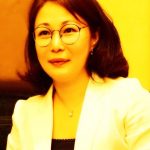 |
3. Ding Li 丁莉 (Peking University 北京大學): 永远的“唐土”——日本平安朝物语的中国叙述與中國書籍 (dingli_ly@126.com) 丁莉,北京大学东方文学研究中心/北京大学外国语学院日本语言文化系教授。主要研究方向为日本古典文学,中日文学与文化关系。主要论著有『伊勢物語とその周縁―ジェンダーの視点から―』(風間書房、2006年)、《永远的“唐土”——日本平安朝物语文学的中国叙述》(北京大学出版社,2016年)等。曾获得2007年度日本关根奖,中国宋庆龄基金会第五届(2008年)和第八届(2017年)孙平化日本学学术奖励基金专著类一等奖。 |
|
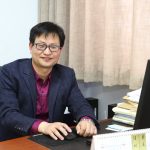 |
4. Ge Jiyong 葛继勇 (Zhengzhou University 鄭州大學): 域外出土简牍与中日书籍之路 (keiyuu@163.com) Ge Jiyong is a full professor of Zhengzhou University who got PhD in 2006 from Institution of Japanese Culture in Zhejiang University. From then on, he served as a full-time faculty in School of Foreign Languages in Zhengzhou University. As a Visiting Scholar, he went to Waseda University for three years from September 2011. His studies focus on history of cultural exchanges between China and Japan, classical documents and East-Asian Relations. Professor Ge has issued more than 50 papers home and abroad, of which 22 papers have been issued in key academic periodicals in China, such as Journal of Zhejiang University (level A), Cultural Relics (level B), Foreign Language Research and Journal of Japanese Language Study and Research, 17 papers have been issued in authoritative periodicals in Japan and 3 papers have been issued in well-known periodicals in South Korea. He is also the author of several books, such as academic monograph Research on Dispatched-Chinese People of Tang Dynasty to Japan in 7 th to 8 th Century (The Commercial Press, 2015), Road of Books Between China and Japan (co-author, Beijing Library Press). What’s more, Professor Ge also held some projects funded by The National Social Science Fund of China, and the newest one is a major project, called “Collection of History of Cultural Exchanges Between China and Japan”(cooperative version by Chinese and Japanese scholars), the duration of which is five years, from 2017–2022. |
|
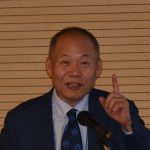 |
5. Hao Chunwen 郝春文 (Capital Normal University 首都師範大學): 從敦煌寫本看絲綢之路上的文獻交流 (haochunw@cnu.edu.cn) Prof. Hao is a senior professor of the School of History at Capital Normal University, also serving as the head of the university’s Institute of Historical Studies. He received his doctorate in History in 1999 from the Department of History at Capital Normal University. His main areas of research are Dunhuang Documents, Buddhism in China, and Chinese History, especially from the 3rd to 13th century. In the past few decades, he has published several monographs on various related topics, which include Zhonggu shiqi sheyi yanjiu 中古時期社邑研究 (The Study of Confraternities in Medieval China), Tang houqi Wudai Song chu Dunhuang sengni de shehui shenghuo 唐後期五代宋初敦煌僧尼的社會生活 (The Social Life of Buddhist Monks and Nuns in Dunhuang during the Late Tang, Five Dynasties, and the Early Song), Shishi xiejing: Dunhuang yishu 石室寫經——敦煌遺書 (Scriptural Manuscripts in Stone Chambers: Dunhuang Documents), Dunhuang de lishi he wenhua 敦煌的歷史和文化 (The History and Culture of Dunhuang) (co-author), and Dunhuang sheyi wenshu jijiao 敦煌社邑文書輯校 (A Critical Collection of Documents concerning Confraternities from Dunhuang) (co-author). In addition, he was the chief editor of Vol. 12-14 in a multi-volume collection of Dunhuang manuscripts which are preserved in the United Kingdom and have published a host of articles. His current primary work-in-progress is an investigation of Dunhuang documents kept in the U.K., with the goal of collecting and studying the data related to social history. This is one of the major research projects sponsored by the National Social Science Fund of China. The outcome of this project will be a 30-volume series Ying cang Dunhuang shehui lishi wenxian shilu 英藏敦煌社會歷史文獻釋錄 (Annotated Transcription of the Dunhuang Literature concerning Social History Preserved in the U. K.), of which 15 volumes have already been published. He associate himself widely with academic institutions, serving as a chairman or committee member. These posts include President of the Institute of Dunhuang and Turfan Studies of China, Chief Editor of Dunhuang xue guoji lianluo weiyuanhui tongxun 敦煌學國際聯絡委員會通訊 (Newsletter of International Liaison Committee for Dunhuang Studies), chief editor of Dunhuang Tulufan yanjiu 敦煌吐鲁番研究 (Studies on Dunhuang and Turfan), and editorial member of Zhongguo shi yanjiu 中國史研究 (Journal of Chinese Historical Studies). He believes that exchange and collaboration beget academic passion and inspire new ideas, and have thus kept himself active in academic conferences and visits. He began his teaching career at Beijing Teachers’ College in 1986, and later joined Capital Normal University. In 1994, he was promoted to full professor for his special contributions in research and teaching. He has taught many courses for both graduate and undergraduate students, such as “Chinese pre-modern history”, “The History of Sui, Tang, and the Five Dynasties”, “Introduction to Tunhuangology”, “Studies of Dunhuang Documents”, “Topics in Historical Theories”, to name but a few. He is frequently invited to teach courses in other universities both abroad and at home, such as Princeton University, Yale University, National Chung Cheng University, and Nanjing Normal University. |
|
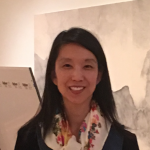 |
6. Ellen Huang 黃愛倫 (Stanford University): Blue-on-White Porcelain as Cultural Geography of the Silk Road (ellen.huang@aya.yale.edu) Ellen Huang, Ph.D. is a historian of art, technology, and material culture. She holds degrees from Yale University and UCSD. Her research and teaching integrate the applied and natural sciences with the history of material culture. She has held postdoctoral teaching positions at UC Berkeley, East China Normal University (Shanghai), and the University of San Francisco. In addition to publishing in catalogues and academic journals, she has organized exhibitions around the collections of the Cantor Arts Center, Asian Art Museum SF, Jingdezhen Ceramic Institute, and National Palace Museum. Among her most enjoyable experiences include teaching collections-based classes for AAMSF and for the Andrew Mellon Chinese Object Studies Program (with Professor Patricia Berger). She is currently completing a monograph about material transformation through an exploration of Jingdezhen porcelain (ca. 1600-1900) |
|
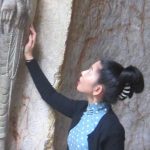 |
7. Shih-shan Susan Huang 黃士珊 (Rice University): Elite Uighurs as Cultural Middlemen of Buddhist Books and Woodcuts in the Mongol Empire (sh6@rice.edu) Shih-shan Susan Huang 黃士珊, Associate Professor of Art History at Rice University, is a Chinese art historian specializing Buddhist and Daoist visual cultures in Middle Period China. Huang received her MA from the National Taiwan University and PhD from Yale University. Her book Picturing the True Form: Daoist Visual Culture in Traditional China (Harvard University Asia Center, 2012; paperback, 2015; Chinese translation, forthcoming in 2018), which investigates the long-neglected visual culture of Daoism, reveals three central modes of Daoist symbolism—aniconic, immaterial, and ephemeral—and shows how Daoist image-making goes beyond the traditional dichotomy of text and image to incorporate writings in image design. Huang is the co-editor of the recent volume, Visual and Material Cultures in Middle Period China (Brill, 2017), which examines key features of Chinese visual and material cultures, ranging from tomb designs, ceramic pillows, to printed illustrations, calligraphic rubbings, and Buddhist and landscape paintings. Her latest articles published in Journal of Daoist Studies, Zhejiang University Journal of Art and Archaeology, and Journal of the Silk Road Studies explore various topics on Daoist seals, Xi Xia Buddhist woodcuts, and painting and printing interaction. She is completing the book-length manuscript Chinese Buddhist Woodcuts and Cultural Transformation, 850 to 1450, whose cross-cultural perspective highlights nomads and non-Chinese peoples as agents of cultural transformation. Its multi-disciplinary approach goes beyond art history and responds to current discourses on print culture, materiality of books, transnational Buddhism, and global history. Huang’s research received generous support from the Scholar Grant of the Chiang Ching-kuo Foundation (CCFK) and the American Council of Learned Societies(ACLS) Frederick Burkhardt Residential Fellowships for Recently Tenured Scholars. For more information, visit https://arthistory.rice.edu/faculty/susan-huang |
|
 |
8. Keyworth, George 紀强 (University of Saskatchewan): Vowing the Buddhist Canon along the Silk Road(s): A Study of Colophons to Manuscripts from Dunhuang and Ancient Japan (george.keyworth@gmail.com) Dr. Keyworth received his B.A. (Honors) in Chinese and Asian Studies and M.A. in Asian Studies from the University of California, Santa Barbara (UCSB). He received his Ph.D. in Chinese Buddhist Studies from the University of California, Los Angeles (UCLA). Dr. Keyworth was an Assistant Professor of East Asian Religions at the University of Colorado at Boulder (CU-Boulder) from 2001-2006, followed by three years as a researcher in Kyoto, Japan, from 2006-2009. In 2011, Dr. Keyworth joined the Department of Religious Studies at the University of Saskatchewan in Canada as an Assistant Professor of Buddhist Studies and East Asian Religions. After receiving tenure in 2017, Dr. Keyworth transferred to the Department of History, where he will teach courses in the areas of premodern Chinese and Japanese history, Asian Studies, the history of religion in East Asia, and comparative manuscript studies.Dr. Keyworth has published several articles on topics ranging from Northern Song dynasty (960-1127) Chinese Chan Buddhism and the figure of Juefan Huihong 覺範惠洪 (1071-1128); Japanese pilgrims to Song China (e.g., Jōjin 成尋 [1011-1081]); apocryphal Chinese Buddhist scriptures and the particular case of the Shoulengyan jing 首楞嚴經 (*Śūraṃgama-sūtra, T no. 945) using Chinese and Khotanese Sanskrit sources from Dunhuang; esoteric Buddhism in Tang (618-907) and Song China; Zen Buddhism in Edo (1603-1868) Japan and the figures of Xinyue Xingchou 心越興儔 (Shin’etsu Kōchū, 1639-1696) and Kakumon Kantetsu 覚門貫徹 (d. 1730); and old Japanese manuscript Buddhist canons (issaikyō一切経), especially from Nanatsudera 七寺 the Matsuo shrine 松尾社 canon kept at Myōrenji. He is currently working on two books, tentatively titled: Zen and the Literary Arts and Copying for the Kami: A Study and Catalog of the Matsuo Shrine Buddhist Canon. He has received grants from the Social Sciences and Humanities Research Council (SSHRC) of Canada to support his research projects. He has also supervised M.A. students who wrote theses on topics ranging from modern religion in China and Japan to early modern Daoism. |
|
 |
9. Liu Yi 劉屹 (Capital Normal University): 憍賞彌國法滅故事在於闐和吐蕃的流傳 (wensi6@hotmail.com) LIU Yi is professor and Dean of School of History at Capital Normal University and also the secretary of the Association of the Dunhuang and Turpan studies in China. His research interests include the Dunhuang studies and the medieval history of religion. For the past 20 years, he has been working on the history of Daoism and the Daoist scriptures. In terms of the former, he challenges the historical paradigm in which the sect of the Celestial Masters came directly down from the sect of the Five Pecks of Rice in the early Daoist history. In terms of the latter, he has specialized in the studies of such Daoist texts as Scripture on Great Peace, Xiang’er’s Commentary on Laozi, and Classic on Laozi’s Conversion of the Barbarians, and the Lingbao Scriptures of the Six Dynasties. He has recently shifted his research to the medieval Buddhist studies and is especially interested in the issue of the “Age of Dharma Decline.” He has published about 110 research articles, book reviews, and translated articles and 6 books and collected volumes. The latest books include Historical Research on the Daoist Guling Baojing in the Six Dynasties (2018) and Research on the History and Scriptures of the Daoism in the Han and Tang Dynasties: Selected Works of Liu Yi (2015) . |
|
 |
10. Machi Senjurō 町泉壽郎 (Nisho gakusha University 二松學舍大學): 19世紀フランス東洋学者の蔵書からみる東西書籍文化交流 (從19世紀法國東洋學者的藏書看東西書籍文化交流) (s-machi@nishogakusha-u.ac.jp) 町 泉寿郎(MACHI Senjuro)1969年石川県生。博士(文学)。職歴、北里研究所研究員、二松學舍大学教授。専門分野、日本漢学史、日本医学史。編著書(含共著)、『渋沢栄一は漢学とどう関わったか』2017,『(柿村重松遺稿)松南雑草 (近代日本漢学資料叢書)』2017, 『浄土真宗と近代日本 : 東アジア・布教・漢学』2016,『曲直瀬道三と近世日本医療社会』2015,『備前岡山の在村医中島家の歴史』2015, 『シーボルト日本書籍コレクション現存書目録と研究』2014,『Listen, Copy, Read:Popular Learning in Early Modern Japan』2014,『大学聴塵 翻印之部(清原宣賢漢籍抄翻印叢刊)』2011,『近代日中関係史人名辞典』2010,『近代日本の仏教者:アジア体験と思想の変容』2010, 『小野蘭山』2010。 |
|
|
|
11. Nathalie Monnet 蒙曦 (French National Library): Far Away from the Silk Road: A Comparison Between the Thousand-Armed Guanyin Paintings at Dunhuang and the 12th Century Daliguo Fanxiang Juan 大理國梵像卷.(monnet@me.com) After attending classes at National Taiwan University, Nathalie Monnet received her PhD from the Université Paris VII and her Habilitation à diriger des recherches (HDR) from the École Pratique des Hautes Études (IVe Section) in Paris. She is the curator of the Pelliot Dunhuang manuscript and Chinese rare book collections at the Bibliothèque nationale de France (French National Library), and an associated member of the East Asian Civilisations Research Center (CRCAO, a research unit of the French National Center for Scientific Research, CNRS). Part of her research activity is devoted to the history of the book in China and its significance for the development of French sinology. She has discoursed and written on the Duc du Maine’s patronage of French Jesuit missions in the 17th century and the legacies that Abel-Rémusat, Paul Pelliot, and Wang Zhongmin 王重民 left at the BnF. Since 1989, she has worked and published on many aspects of the extensive collection of Chinese books and manuscripts kept at the Department of Manuscripts, including Qing imperial editions and the Chinese books edited by Jesuits in China throughout the 17th and 18th centuries. She co-curated exhibitions at the French National Library, Impressions de Chine and Tous les savoirs du monde,and curated the BnF’s largest ever Chinese exhibition, Chine, l’Empire du trait, while authoring its catalog, half of which is devoted to the manuscripts, rubbings, woodblock prints and paper paintings retrieved from Dunhuang Cave 17. She has collaborated with Shanghai Guji Chubanshe for the publication of the complete facsimile of the Pelliot manuscripts collection, the 法國國家圖書館藏敦煌西域文獻, including the 漢文文獻, 藏文文獻, 西夏文文獻, and with Dr. Zhao Feng 趙豐, for the publication of the 法國國家圖書館藏敦煌紡織品 in 敦煌絲綢藝術全集: 法藏卷. At the 2008 Symposium commemorating Paul Pelliot at the Collège de France, she examined in detail the historical conditions surrounding the deposit of the Pelliot manuscripts at the BnF. At the Beijing conference 中国敦煌吐鲁番学会成立三十周年 国际学术研讨会, she presented her findings, later published in Chinese under the title “王重民巴黎往事追記 (1934-1939),” on the work done by Wang Zhongmin 王重民. She has also presented papers at conferences on Dunhuang studies in Dunhuang, Lanzhou, Shanghai, Peking, Kyoto, Saint-Petersburg, Los Angeles, Princeton, London, and Paris. At the 2016 “Cave Temples of Dunhuang Symposium,” held at the Getty Center and UCLA, she presented a study on “The Lion-Bull Symplegma in Manuscript Pelliot Chinois 4524.” The scroll depicts several episodes of the Magic Competition between Sariputra and Raudraksha and one motif highlights the exemplary case of its transmission in space and time which can currently be traced back to Old Sumer during 13th century B.C.E, later appears in artwork in the ancient world of the Mediterranean, and finally spreads to the Arabo-Persian world and Central Asia. At the 2016 conference on Buddhist Manuscript Cultures at Princeton, she presented some of her latest research in a paper entitled “Towards a Reassessment of the Contents of Dunhuang Cave 17: Research on the Derivative Aspects of the Dunhuang Manuscripts,” in an attempt to reevaluate the original contents of the cave based on the appearance of the scrolls at the time of the sealing of the cave at the beginning of the 11th century. At the Harvard-Yenching Library workshop on “The Chinese Book as a Material Object,” in May 2017, she presented an overview of the “Early Prints from Dunhuang Kept at the Bibliothèque Nationale de France.” |
|
 |
12. Jason Neelis 禰傑⽣ (Wilfrid Laurier University): “Hanging Passages, Maitreya’s Missing Shrine, and King Shibi’s Flesh Sacrifice on Upper Indus Book Roads” (jneelis@wlu.ca) Jason Neelis 禰傑⽣, Associate Professor and Chair, Religion and Culture Department, Wilfrid Laurier University (Waterloo, Ontario, Canada), completed a PhD in Asian Languages and Literature at the University of Washington (2001). His publications include Early Buddhist Transmission and Trade Networks: Mobility and Exchange within and beyond the Northwestern Borderlands of South Asia (Brill, 2011). His research focuses primarily on South Asian Buddhist epigraphy and manuscripts of literary texts as sources for historical patterns of religious and cross-cultural transmission. He co-ordinated a collaborative project on Buddhist Rebirth Narratives in Literary and Visual Cultures of Ancient Gandhara funded by the Ho Family Foundation for Buddhist Studies through the American Council of Learned Societies and is directing a project on Upper Indus Petroglyphs and Inscriptions in Northern Pakistan with support from a Partnership Development Grant from the Social Sciences and Humanities Research Council of Canada. He has taught and held research positions at Vienna University, Ruhr University Bochum, Heidelberg Academy of Sciences and Humanities, University of Florida, Florida State University, and Antioch College’s Buddhist Studies |
|
|
|
13. Ng Wai-ming 吳偉明 (Chinese University of Hong Kong ): The Assimilation of the Yijing in Tibetan History and Culture《易經》在西藏的本地化研究 (waimingng@cuhk.edu.hk) Benjamin Wai-ming Ng 吳偉明 is professor of Japanese Studies at the Chinese University of Hong Kong. He is a Princeton-trained historian specializing in Japan-China cultural relations, Yijing scholarship in East Asia and Tokugawa intellectual history. He is the author of The I Ching in Tokugawa Thought and Culture (University of Hawai’i Press, 2000) and Imagining China in Tokugawa Japan (SUNY Press, 2019, forthcoming. |
|
|
|
14. Benjamin J. Nourse 戴德安 (University of Denver): Networks of Commerce, Artifacts, and Books Between Central and East Asia” (benjamin.nourse@du.edu) Ben Nourse 戴德安 is assistant professor of Buddhist Studies at the University of Denver and a Senior Fellow with the Andrew W. Mellon Society of Fellows in Critical Bibliography at the Rare Book School. He received a BA in Asian Studies from the University of Wisconsin-Madison and a MA and PhD in Religious Studies from the University of Virginia. He is currently at work on a book-length study of the growth and impact of Tibetan woodblock publishing from the seventeenth through the nineteenth centuries. Most of his other projects are related to the history of Buddhist scriptures, including the history of the Tibetan Buddhist Canon (the Kangyur and Tengyur) and a study of the Dunhuang manuscripts of the Heart Sūtra in Chinese and Tibetan. He has been active in promoting the study of Tibetan book history through the hosting of conferences such as The Symposium on the Tibetan Book (University of Virginia, 2014) and Buddhist Book Cultures (University of Denver, 2017) as well as co-editing a forthcoming volume on material approaches to the study of Tibetan books. He has received numerous fellowships and grants including a Fulbright-Hays Fellowship, a Florence Tan Moeson Fellowship from the Asian Division of the Library of Congress, an Andrew W. Mellon Fellowship in Critical Bibliography at the Rare Book School, and grants from the University of Wisconsin Libraries and the Jefferson Trust. |
|
 |
15. Christopher Nugent 倪健 (Williams College): “From Chang’an to Dunhuang: A Capital Education on the Silk Road” (cnugent@williams.edu) Christopher M. B. Nugent 倪健 is Professor of Chinese and Chair of the Program in Comparative Literature at Williams College. He did his doctoral work in East Asian Languages and Civilizations from Harvard University with Stephen Owen and his research focuses on the literary culture of the sixth through tenth centuries. His first book, Manifest in Words, Written on Paper: Producing and Circulating Poetry in Tang Dynasty China (Harvard University Asia Center, 2010) won the 2012 Joseph Levenson Book Prize, Pre-1900 Category. His second book, currently near completion, is tentatively entitled The Textual Practices of Literary Training in Medieval China and is based on his study of ninth-century educational manuscripts from the finds at Dunhuang. |
|
 |
16. Ryan Overbey 歐銳恩 (Skidmore College): “A Gandhāran among the Turks: Buddhist Texts and Travels in the Biography of Jñānagupta (528–605)” (roverbey@skidmore.edu) Ryan Richard Overbey studies the intellectual and ritual history of Buddhism, with particular focus on early medieval Buddhist spells and ritual manuals. He studied at Brown University (AB in Classics & Sanskrit and Religious Studies, 2001) and at Harvard University (Ph.D. in the Study of Religion, 2010). He currently serves as the Robert H. N. Ho Family Foundation Assistant Professor of Buddhist Studies at Skidmore College. |
|
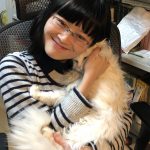 |
17. Qu Yandan 瞿艷丹 (Kyoto University): Kobayashi Shashinkan 小林写真館 and the Publishing History of Manchukuo: Focus on the Photocopying and Publishing of Daqinglichao shilu 大清歴朝実録 (Veritable Records of Successive Reigns of the Qing Dynasty) (quliuqing@gmail.com) Yandan Qu is a Ph.D. Student of Graduate School of Letters at the Kyoto University (April, 2015-), where she earned her M.A of Laws and M.A of History from 2009 to 2015. Her studies focus on history of the books and reading, the communication of classic documents in East-Asian. She is the author of some journal articles, with major academic journals such as Chinese Classics and Culture, Chinese Publishing History Research. She also wrote a bibliographical introduction for Jingsong danshuben Zhouyizhengyi (景宋單疏本周易正義, Zhejiang Classics Publishing House, 2017), researched Fuzengxiang’s (傅增湘) photocopying work on Zhou yi zheng yi (周易正義). |
|
|
|
18. Pénélope Riboud 黎北嵐 (Inalco, Paris/ISAW): Zoroastrian rituals and hu gatherings: A critical study of images of Sogdian festivals in China (penelope.riboud@inalco.fr) Penelope Riboud 黎北嵐, an Assistant Professor of Chinese History and Art History at Inalco in Paris, works on the society and visual culture of Medieval China. She was trained in France as a historian, an archaeologist and a sinologist and teaches China’s Ancient History (pre-Song), Art History and History of Religions. During the Academic year 2018-2019, she will be holding a position as visiting research scholar at the Institute for the Study of the Ancient World (ISAW) in New York. She is mainly interested in exploring the multiple facets of social and religious life in medieval China based on the cross-examination of textual, epigraphic, archaeological and visual material. Her research has led her to investigate agents of religious circulation between Central and Inner Asia, and China, and therefore has focused on the people (individuals or groups), texts or objects (artworks and material culture) that were actors of this transmission. She is currently working on a monograph tentatively titled Defining “xian 祆”: an investigation into the visual, textual and archaeological sources of Zoroastrianism in medieval China. Other projects she has been involved in these past few years have focused on social and ritual attitudes towards death in multicultural environments, such as the development of hell imagery in China and Central Asia, or the economic repercussion of death in medieval China. |
|
 |
19. Stephen Roddy 斯定文 (University of San Francisco): From Tamagawa to Yurungkash: Poetry Across the Silk/Book Road(s) (roddys@usfca.edu) Stephen Roddy 斯定文 received his Ph.D. in East Asian Studies from Princeton University (1990) and is currently Professor of Modern Languages and Director of Asian Studies at the University of San Francisco. His research focuses on the intersections between institutional change and literary expression in late-traditional China and Japan. He has written articles and monographs on topics such as representations of literati in late-imperial Chinese fiction, literati tea (bunjincha) in Japan, the incorporation of Chinese narratives into Edo yomihon, Sino-Japanese and Sino-Korean scholarly exchanges ca. 1850-1900, the Qing examination system (keju) and its prescribed essay form (baguwen), and Chinese travel poetry in frontier areas (Guizhou, Taiwan, Tibet, and Xinjiang). In recent years he has held research and/or teaching positions at Sogang University, the National Library in Taipei, Nanjing University, and Peking University. |
|
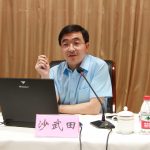 |
20. Sha Wutian 沙武田 (Research Institute of Dunhuang 敦煌研究院): 絲綢之路絹帛圖像考——以敦煌畫和唐墓駱駝俑為中心 (shawutian@163.com) Sha Wutian is professor of School of history and civilization,Research Central for the Study of Silk Road History and Culture,Shaanxi Normal University, Research fellow of Dunhuang Academy. He also serves as an adjunct professor in the Northwest University of Nationalities, Northwest Normal University, and the Institute for Dunhuang Studies at Lanzhou University,Shaanxi History Museum. Doctor Sha graduated from Northwest University in July 1996 with a Bachalor degree in archaeology, then he pursued both his Master and Doctor degrees in the Institute for Dunhuang Studies at Lanzhou University from September 1999 to July 2005. Doctor Sha then worked as a postdoc in the history department of Lanzhou University from May 2006 to September 2008, and visited Tokyo University of the Arts as a visiting senior researcher from October 2008 to October 2009.Doctor Sha has published nine academic books, including 《敦煌画稿研究》 (A Study on Rough Sketches from Dunhuang), 《吐蕃统治时期敦煌石窟研究》(A Study on the Dunhuang Caves under the Tubo Rule),《敦煌石窟艺术概论》(An Introduction to the Arts of Dunhuang Caves) , 《榆林窟第25窟:敦煌图像中的唐蕃关系》(Yulin cave 25: Relationship between Tang and Tobo in Dunhuang image),《归义军时期敦煌石窟考古研究》(An Archaeological study of Dunhuang Caves during the period of Gui-yi-jun), and etc. He has also published about 130 articles and conducted 18 research projects, including three projects funded by the National Social Science Foundation of China, a sub-project of National 973 Plan, and various projects funded by the Education Bureau of China, China Postdoc Science Foundation, Gansu Province Social Science Plan, and etc. He once won the first and third prizes of Excellent Achievements of Social Science in Gansu Province, National Award Nomination of One Hundred Excellent Dissertations, and Advanced Individual in Culture Heritage Preservation in Gansu Province. Doctor Sha mainly focuses on the caves of Dunhuang in the Tubo (Tibet) Period, Dunhuang caves Art under the influence of Sogdian, the archaeology of Dunhuang Caves and grotto arts, including grotto archaeology, iconology, history of Buddhist arts, and Dunhuang literature, the silk road history and civilization. |
|
|
|
21. Shen Weirong 沈衛榮 (Tsinghua University 清華大學): 西夏時代漢藏、顯密佛教的交流和圓融——黑水城出土漢文、西夏文佛教文獻的比較研究 (The Interaction and Integration of Chinese and Tibetan, Exoteric and Esoteric Buddhism in the Kingdom of Tangut Xia (1132-1227): A Comparative Study of Chinese and Tangut Buddhist Texts among the Kharakhoto Collection) (shenweirong@yahoo.com) Weirong Shen is a Professor of Tibetan and Buddhist Studies at the Institute for Advanced Study of Humanism and Social Sciences in Tsinghua University, China. His research focuses on Tibetan Buddhist history and the history of the spread of Tibetan tantric Buddhism in Central Eurasia and China Proper from the twelfth through the sixteenth centuries. He received his Ph.D for Central Asian Philology at Bonn University, Germany, with his dissertation Leben und historische Bedeutung des ersten Dalai Lama dGe ’dun grub pa dpal bzang po (1391-1474)— Ein Beitrag zur Geschichte der dGe lugs pa-Schule und der Institution der Dalai Lama (Monumenta Serica Monograph Series XLIX, P. 1-476, ISBN 3-8050-0469-9, Styler Verlag, Institut Monometa Serica, St. Augustin, Germany, 2002). His recent publications include Philological Studies of Tibetan Buddhism and History (Shanghai guji chubanshe, 2010); Imaging Tibet (Beijing Normal University Press, 2015); Text and History: The Making of Tibetan Buddhist Historical Narratives and the Construction of Sino-Tibetan Buddhist Studies (Beijing University Press, and China Tibetology Publishing House, 2015). |
|
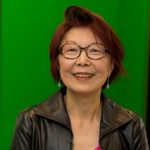 |
22. Angela Sheng 盛餘韻 (McMaster University): Reading Textiles as Documents: Knowledge Transmission across Inner Asia in the First Millennium (shenga@mcmaster.ca) Angela Sheng 盛餘韻 is Associate Professor in Art History, School of the Arts, McMaster University in Hamilton, Ontario, Canada since 2005, also appointed Consulting Scholar at the University of Pennsylvania Museum of Archaeology and Anthropology since 2016 (her alma mater). Previously a curator of Asian textiles at the Royal Ontario Museum (1985-1994), she began working on “Silk Road” textiles in 1996 as a participant of the Reuniting Treasures of Turfan project co-organized by Yale and Beijing Universities. She reads costumes and textiles both as functional art and as documentation of human negotiation with others and with time, place, and space for individual and collective reasons. From 2005 to 2008 she curated the touring exhibit and catalogue, Writing with Threads: Traditional Textiles of Southwest Chinese Minorities, based on the collection at Evergrand Museum in Taiwan and organized by the University of Hawai’i Art Gallery. Reading textiles as documents, she elucidated how simple silks served as currency in Han-Tang China (Journal of the Royal Asiatic Society 2012). Interested in cross-border interculturality, she guest-edited a special issue on gender and technology for East Asian Science, Technology and Medicine highlighting the work of three art historians (2012). Aiming to give voice to those who left few texts—artisans, women, and nomads, she is currently working on a new project focusing the nomadic contribution to knowledge transfer in the first millennium, for which she received a five-year Insight Grant from the Social Sciences and Humanities Research Council of Canada (SSHRCC) in 2017. https://www.humanities.mcmaster.ca/~sheng/index.html |
|
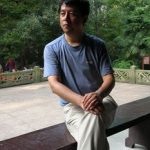 |
23. Shi Rui 史睿 (Peking University): 唐代書法文獻的東傳——以最澄和空海爲中心 (shirui@pku.edu.cn) 史睿:2003年7月畢業於首都師范大學歷史系,獲博士學位。主要研究方向:敦煌吐魯番文獻、隋唐五代史、書畫鑒藏史等。曾發表《北周后期至唐初禮制變遷與學術文化的統一》(《唐研究》第三卷,北京大學出版社,1997年)、《俄藏敦煌寫本唐令殘卷(Дx.3558)考釋》(與榮新江合作,《敦煌學輯刊》1999年第1期)、《敦煌吉凶書儀與東晉南朝禮俗》(郝春文主編《敦煌文獻研究——紀念敦煌藏經洞發現一百年國際學術研討會論文集》,沈陽:遼寧人民出版社,2001年)、《唐代外官考課的法律程序》(《文津學志》第一輯,北京:北京圖書館出版社,2003年)、《唐代前期銓選制度的演進——從新獲吐魯番銓選文書談起》(《歷史研究》2007年2期)、《南北朝士族婚姻禮法的比較研究》(榮新江主編《唐研究》第十三卷,北京大學出版社,2007年)、《唐代法書鑒藏家的譜系——從武平一到司空圖》(《高田時雄教授退職記念 東方學研究論集》中文分冊,臨川書店,2014年)、《唐代兩京的書畫鑒藏與士人交游——以張彥遠家族為核心》(榮新江主編《唐研究》第二十一卷,北京大學出版社,2015年)、《隋唐書法屏風考——從莫高窟220窟談起》(榮新江主編《唐研究》第二十三卷,北京:北京大學出版社,2017年)等三十余篇論文。參與編纂郝春文編著《英藏敦煌社會歷史文獻釋錄》(第1卷,科學出版社,2001年﹔第2-5卷,北京:社會科學文獻出版社,2004-2006年),榮新江、李肖、孟憲實主編《新獲吐魯番出土文獻》(中華書局,2008年),胡戟、榮新江主編《大唐西市博物館藏墓志》(北京大學出版社,2012年10月)等書。 |
|
 |
24. Kirill Solonin 索羅寧 (Renmin University of China): Tangut Buddhism and the Buddhist networks of the Silk Road (kirill_solonin@mail.ru) 索羅甯教授 1969生, 求學於聖彼德堡國立大學(俄羅斯), 漢學家和佛學家。在聖彼德堡國立大學獲得這兩個高級學位、並在那裡和俄羅斯科學院的東方寫本研究院工作了幾年後,他移居臺灣,隨後工作於臺灣的幾所大學與研究所(包括輔仁大學),直至被任命為佛光大學東亞佛教的副教授。2013年起為中國人民大學國學院教授,主要從事佛學,西夏學,語言學研究,漢藏交流等。除了專著《教義之襲取: 西夏國的華嚴-禪佛教》 (Obretenie Uchenia: Tradicia Huayan-Chan v Buddhisme Tangutskogo Gosudarstva, Petersburg University, 2007)外,還撰有大量涉及中國和西夏佛教的文章。主要文章包括《Dīpaṃkara in the Tangut Context》, 1-2 (Acta Orientalia, 2016); 《Tangut Buddhist literature》收錄在J Silk et al. eds., Brill Encyclopedia of Buddhism (2016), “Atiśa Satyadvayāvatāra in the Tangut Translation” (Journal of Indian Philosophy) 等數十篇文章。 |
|
|
25. Mingli SUN (The University of British Columbia 加拿大英屬哥倫比亞大學): A Glimpse into the Transformation of Buddhist Art from Gandhāra to China: With a Focus on the Image of a Contemplative Bodhisattva in a half-lotus Posture 加拿大英屬哥倫比亞大學博士生,從事佛教物質文化研究。已在《故宮博物院院刊》、《大足石刻全集》、《石窟藝術研究》等雜誌發表學術論文數篇(包括《大足石刻观无量寿经变分析》、《四川唐五代观无量寿经变光明转与宝船因素分析》、《四川唐五代摩崖浮雕观无量寿经变分析》等)。 |
||
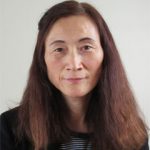 |
26. Mariko Namba Walter 南波マリ子 (ACANSRS/Harvard): Khotanese and Uighur versions of the Lotus Sūtra and Avalokiteśvara worship in pre-modern Central Asia (mnwalter@acansrs.org) Mariko Namba Walter 南波マリ子 is Executive Director of ACANSRS (Association for Central Asian Civilizations and Silk Road Studies). Prior to the position, she taught Asian Religions at various American Universities. She is the primary editor of The Silk Road: Interwoven History, vol. 1 and also published many articles regarding the history of Buddhism along the Silk Roads including Tokharian and Sogdian Buddhism. |
|
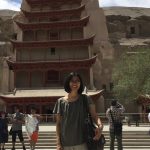 |
27. Michelle C. Wang 王慧兰 (Georgetown University): Birds of a Feather: Mahāmayūrī between Khotan and Dunhuang (mcw57@georgetown.edu) Michelle C. Wang 王慧兰 is Assistant Professor in the Department of Art and Art History at Georgetown University. A specialist in medieval Chinese art, her publications have addressed Buddhist maṇḍalas, Dunhuang painting, and art of the Silk Road. Her first monograph, Maṇḍalas in the Making: The Visual Culture of Esoteric Buddhism at Dunhuang (Leiden and Boston: Brill, 2018) analyzes the Maṇḍala of Eight Great Bodhisattvas at the Mogao and Yulin caves during the Tibetan and Guiyijun periods, demonstrating that transcultural communication over the Silk Routes, and the religious dialogue between Chinese and Tibetan communities, were defining characteristics of Buddhist maṇḍalas at Dunhuang. She was also a co-organizer of the 2014-2015 John E. Sawyer Seminar, “Critical ‘Silk Road’ Studies.” |
|
|
|
28. Wang Yong 王勇 (Zhejiang University 浙江大學): 奈良时代的书籍之路——以第十二次遣唐使为例 (japanology@163.com) 王勇,1956年4月出生。歷任浙江大學日本文化研究所所長、北京大學中文系特聘教授,並先後在日本早稻田大學、國際日本文化研究中心、文部省國文學研究資料館、美國哥倫比亞大學等擔任客座教授、研究員,現為復旦大學特聘教授、浙江工商大學東亞研究院院長,兼任中國中外關係史學會副會長、中國日本史學會副會長等。 專事東亞文化交流史、“書籍之路”研究,兼及日本歷史文化、隋唐外交史研究。迄今出版各類著作46部(其中國外出版22部),《中日漢籍交流史論》(杭州大學出版社,1992)獲國家教委首屆人文社科優秀成果二等獎;合作主編的10卷本《中日文化交流史大系》(浙江人民,1996)獲亞太出版協會(APPA)學術類金獎,《日本文化——模仿與創新的軌跡》(高等教育出版社,2001)獲浙江省教育廳哲學社會科學優秀成果一等獎。此外,在《文獻》、《文學遺產》、《日本學刊》、《文學》、《國文學解釋與鑒賞》、《汲古》等國內外著名刊物發表論文約200篇。主要著作: (1)《中日關係史考》(單著,北京: 中央編譯出版社,1995); (2)《唐視野中的遣唐使》(單著,東京:講談社,1998); (3)《中國史籍中的日本像》(單著,東京:農文協出版社,2000); (4)《中日“書籍之路”研究》(合著,北京:北京圖書館出版社,2003);(5)《中日書籍交流史》(單著,東京:國際文化工房出版社,2005); (7)《東亞坐標中的跨國人物研究》(中國書籍出版社,2013); (8)《東亞坐標中的遣唐隋使研究》(中國書籍出版社,2013); (9)《東亞坐標中的書籍之路研究》(中國書籍出版社,2013); (10)《東亞筆談文獻概論》(浙江工商大學出版社,2014)。 |
|
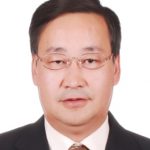 |
29. Wei Wenbin 魏文斌 (Lanzhou University 蘭州大學) : 高僧帛法祖、法祚兄弟的遇害——3世紀後期至4世紀的中國北方佛教 (936998117@qq.com) 魏文斌(Wen Bin Wei) 蘭州大學考古學及博物館學研究所所長,教授,博士生導師。1988年畢業於北京大學考古學系,2009年獲蘭州大學敦煌學博士學位。曾在甘肅省文物考古研究所、麥積山石窟藝術研究所工作。主持發掘甘肅武威白塔寺遺址、高臺駱駝城遺址及麥積山舍利塔等發掘,主要從事考古、佛教考古及佛教藝術研究。著作有《麥積山石窟初期洞窟調查與研究》、《甘肅佛教石窟考古》等,主編《麥積山石窟》、《武山水簾洞 木梯寺石窟》、《甘肅省文物志》等。 |
|
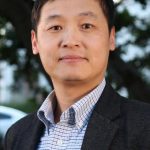 |
30. Wu Jiang 吳疆 (University of Arizona): The Trade of Buddhist Books at Nagasaki in the Late Seventeenth and Early Eighteenth Centuries as Seen from Hakusai shomoku 舶載書目: With Special Attention to the Purchase of the Jiaxing Canon 嘉興藏 and the Role of Ōbaku 黃檗 Monks (jiangwu@email.arizona.edu) Dr. Jiang Wu is currently a professor in Department of East Asian Studies (Tucson) and director of Center for Buddhist Studies at the University of Arizona . He received his Masters degree from Nankai University (1994) and Ph.D. from Harvard University (2002). His research interests include seventeenth-century Chinese Buddhism, especially Chan/Zen Buddhism, the role of Buddhist canons in the formation of East Asian Buddhist culture, and the historical exchanges between Chinese Buddhism and Japanese Buddhism. Other interests include Confucianism, Chinese intellectual history and social history, and the application of electronic cultural atlas tools in the study of Chinese culture and religion. He has published articles in Asia Major, Journal of East Asian History, Journal of Chinese Philosophy, and Monumenta Serica on a variety of topics. His first book Enlightenment in Dispute: The Reinvention of Chan Buddhism in Seventeenth-century China was published by Oxford University Press in 2008. Recent publications include
|
|
 |
31. Wu Lan 烏蘭 (Mount Holyoke College): Epistolary Buddhist Network from Kathmandu to Beijing in the 1740s (lwu@mtholyoke.edu) Lan Wu 烏蘭 teaches East Asian history at Mount Holyoke College (MA, USA). She is broadly interested in the role of religion in imperial formation in the early modern time. She is currently preparing a manuscript on the circulatory Buddhist regime in China’s Inner Asian borderland as the state worked to redraw cultural and political landscape in the region in the eighteenth century. She received her Ph.D. from the History-East Asia Program at Columbia University in 2016. |
|
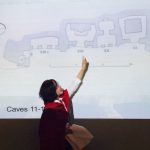 |
32. Lidu Yi 衣麗都 (Florida International University): Cross-cultural Buddhist Cave-chapels: Yungang, the Silk Road and Beyond (lidyi@fiu.edu) Dr. Joy Lidu Yi 衣麗都, Associate Professor of Chinese art and architecture, specializes in visual art and material culture in China. She earned both her M.A. and Ph.D. at the University of Toronto in Canada. Before joining the faculty of the College of Communication, Architecture and The Arts at Florida International University, she was the Gretta Chambers chair visiting professor at McGill University. Dr. Yi’s research interests primarily focus on Buddhist rock-cut cave-chapel art, architecture and archaeology. Currently, she is particularly interested in the art, archaeology and liturgy of Buddhist sanctuaries of medieval China. Her most recent book, Yungang: Art, History, Archaeology and Liturgy, the first-ever comprehensive examination in any western language, provides a social art history of Yungang: a 5th-century rock-cut court cave complex, UNESCO World Heritage site, and one of the greatest Buddhist monuments of all time. It asks why, when, and under what circumstances this impressive cave sanctuary was made, who played significant roles at various stages, and what was the construction dating sequence. The initial question was what Yungang was like in the fifth century and what were the important components of the entire complex. Currently, Dr. Yi has two on-going research projects in China, one is the examination of Buddhist rock-cut cave monasteries on the Silk Road, and the other studies the relatively unknown small caves in Shanxi Province. The former is the subject of the current book manuscript project (tentatively entitled Beliefs, Practices, Donors and Visual Images in Buddhist Caves on the Silk Road). Her project in 2018 and 2019 is mainly on Buddhist cave chapels in Gansu Province on the Silk Road. |
|
 |
33. Yu Xin 余欣 (Fudan University 復旦大學): The Western Frontier of Chinese Official History: Writing and Reading of The History of the Former Han Dynasty in Serindia (yuxin@fudan.edu.cn) Yu Xin is a historian of medieval China and Silk Road, specializing in the study of Dunhuang manuscripts and the Tang dynasty. He received his BA (1997) and MA (2000) from Zhejiang University, and Ph. D (2003) in Chinese History from Peking University. He joined Fudan University in 2003 and now is Professor of Medieval Chinese History. He has held appointments as visiting professor at École des hautes études en sciences sociales, École normale supérieure, Princeton University, Kyoto University, and The Starr Foundation East Asian Studies Endowment Fund Member at the Institute for Advanced Study.Professor Yu’s research interests lie in natural history, manuscript culture, and the social history of religion. He aims to develop a comprehensive understanding of the role of different source materials (historical records, archaeological evidence, bamboo slips and silk texts, Dunhuang and Turfan manuscripts, lost Chinese books in Japan, and literature on Sino-foreign relations) in the production of knowledge and religious practice, and to re-think the role of manuscripts and images in intellectual history, belief, and daily life. He has published numerous books, including Way of Gods, Life of Humans: Social History of Livelihood Religions in Dunhuang during the Tang and Song Dynasties (2006); Signs of the Extraordinary in Medieval China: Erudition, Belief, and Society in the Age of Manuscripts (2011). He is also the chief editor of a series of research monographs: Studies of Knowledge, Faith, and Institutions in Medieval China (12 published to date, and 6 projected in the future, 2012-) as well as the bilingual academic journal Medieval China 中古中國研究. |
|
|
|
34. Zhang Naizhu 張乃翥 (The Academy of the Longmont Grottos 龍門石窟研究院): 西域藝術風尚與洛陽中古石刻美術之互動 (The interactions between the art of stone inscriptions in the Luoyang area and the Central Asian artistic style during the medieval period) 张乃翥,1981年洛阳大学中文系毕业,于龙门石窟研究院从事文化遗产的学术研究至今,副研究员。中国考古学会会员,中国魏晋南北朝史学会会员,中国唐史学会会员,中国海外交通史学会会员,中国敦煌吐鲁番学会理事。丝绸之路沿线的文化交流和西域文明的东方传播,是其几十年来学术研究的重点方向。30多年来在海内外发表学术论文百余篇,出版学术著作13部。曾应邀赴新加坡、韩国、意大利、奥地利、俄罗斯进行国际学术交流和讲学。并访问印度、斯里兰卡及欧洲诸国的众多文化遗产和博物馆。 |
|
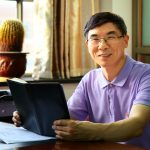 |
35. Zhang Yongquan 張湧泉 (University of Zhejiang): 試論敦煌殘卷綴合的意義 张涌泉,1956年生,浙江义乌人。1992年毕业于四川大学中文系,获文学 |
|

